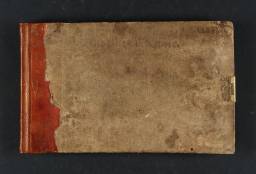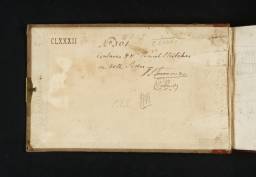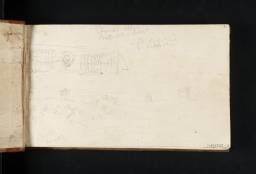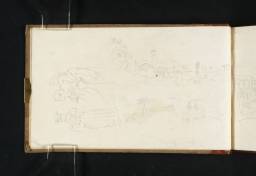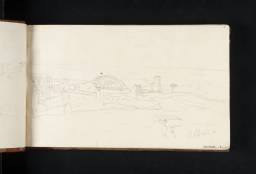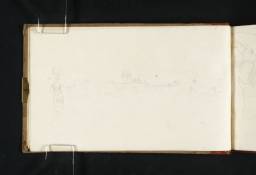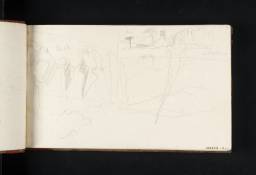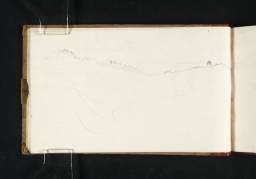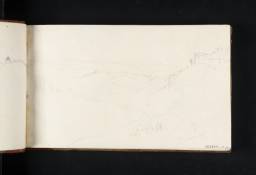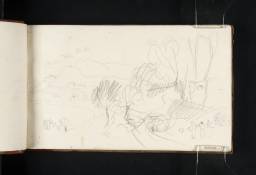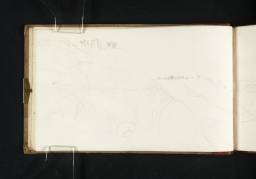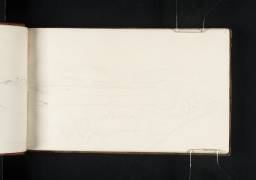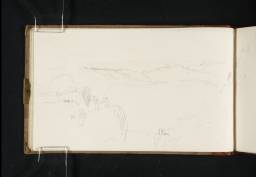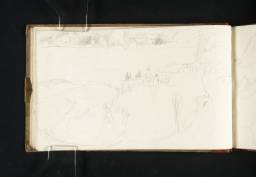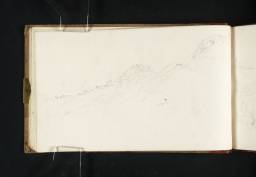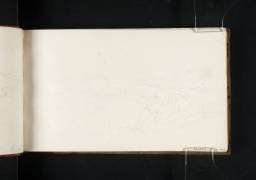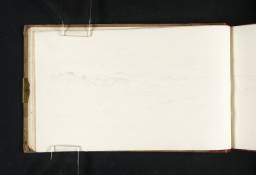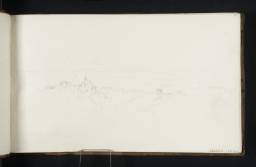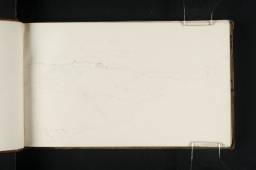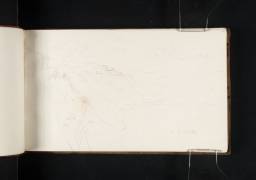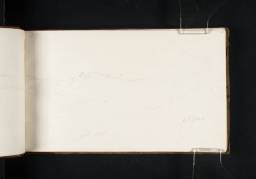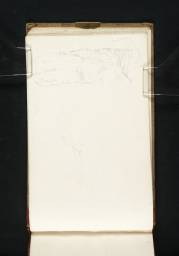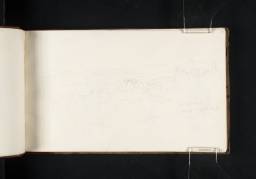Tate, D15296–D15466; D40616–D40618
Turner Bequest CLXXXII
Sketchbook with paper-covered boards bound with red leather spine, and a brass clasp [missing]
89 leaves of white wove writing paper, approximate page size 113 x 189 mm
Made by Thomas Smith and Henry Allnutt, Ivy Mill, Maidstone, Kent; various pages watermarked ‘... & Allnutt | ... 18’.
89 leaves of white wove writing paper, approximate page size 113 x 189 mm
Made by Thomas Smith and Henry Allnutt, Ivy Mill, Maidstone, Kent; various pages watermarked ‘... & Allnutt | ... 18’.
Inscribed by the artist in ink on the front cover ‘Albano Nemi Roma’ along top and ‘Nov. 30 1819’ centre. Finberg also records a label inscribed by the artist on the back of the book which was destroyed when the covers were broken off.
Inscribed in pencil ‘CLXXXII’ top right
Stamped in black ‘CLXXXII’ top right
Inscribed in pencil ‘CLXXXII’ top right
Stamped in black ‘CLXXXII’ top right
Inside front cover (D40617) is numbered ‘301’ as part of the Turner Schedule in 1854 and endorsed by the Executors of the Turner Bequest, inscribed in ink ‘Contains 88 Pencil Sketches | on both Sides | H.S. Trimmer | C. Turner’ and initialled in pencil by Charles Lock Eastlake and John Prescott Knight, ‘C.L.E.’ and ‘J.P.K.’.
Inscribed in pencil by the ?artist ‘[?Mr Kerschman]’ vertically along left-hand edge. Also in pencil ‘56’ and ‘26’ top left-hand corner and ‘16 | 22 | 32’ and ‘[?S. P.15]’ and ‘CLXXXII’ along top
Stamped in ink ‘CLXXXII’ top left
Inscribed in pencil by the ?artist ‘[?Mr Kerschman]’ vertically along left-hand edge. Also in pencil ‘56’ and ‘26’ top left-hand corner and ‘16 | 22 | 32’ and ‘[?S. P.15]’ and ‘CLXXXII’ along top
Stamped in ink ‘CLXXXII’ top left
Accepted by the nation as part of the Turner Bequest 1856
Exhibition history
References
Turner used this sketchbook during his first tour of Italy in 1819, one of twenty-three related to that trip. As the title given by the artist suggests, the scope of the book covers subjects in Rome and the landscape of the nearby Alban Hills, including views of Frascati, Lake Albano and Lake Nemi. Turner may have consulted some of these sketches when preparing later compositions such as the watercolour, Lake Albano circa 1828 (private collection),1 or the unfinished oil sketch, Lake Nemi 1828 (Tate, N03027).2
For the nineteenth-century traveller, Lakes Albano and Nemi and the towns of the Alban Hills, lay within easy reach of Rome and also formed part of the route south towards Naples. Consequently the area had long become an established part of the traditional Grand Tour and had become a favourite subject for poets and artists alike. In addition to the natural beauties of the scenery, the landscape of the region was imbued with historical and classical associations and housed some noteworthy architectural treasures, such as the papal villas at Frascati and the Pope’s palace at Castel Gandolfo. Thomas Jones, who visited this part of Italy in 1776, famously summed up the multiple attractions of the region in his Memoirs:
We then continued Our route through Marino, where there happened to be a fair, and skirting the Lake of Albano, passed through Castello Gondolfo, L’arici and arrived at Gensano in the Evening – This wall considered with respect to its classick locality, the Awful marks of the most tremendous Convulsions of nature in the remotest of Ages, the antient and modern Specimens of Art, and the various extensive & delightful prospects it commands is, to the Scholar, naturalist, Antiquarian and Artist, without doubt, the most pleasing and interesting in the Whole World – And here I can not help observing with what new and uncommon Sensations I was filled on my first traversing this beautiful and picturesque Country – Every scene seemed anticipated in some dream – It appeared Magick Land – In fact I had copied so mnay studies of that great Man, & my Old Master, Richard Wilson, which he made here as in Other parts of Italy, that I insensibly became familiarized with Italian Scenes, and enamoured of Italian forms.3
For an artist of Turner’s interests, ‘Magick Land’ presented an equally alluring combination, and like Jones, an added incentive was his knowledge of the work of other artists, in particular Gaspard Dughet, Claude Lorrain, John Robert Cozens and Richard Wilson. The latter’s landscapes of the Roman Campagna and Cozens’s cool, tonal watercolours of the lakes had provided the young Turner with some of his earliest Italianate references.
The beginning and end of the sketchbook are devoted to Turner’s exploration of the Alban Hills, (see D15296–D15354 and D15451–D40618; Turner Bequest CLXXXII 1–CLXXXII 31a and CLXXXII 80a–inside back cover). He made a number of panoramic studies of Lakes Albano and Nemi as well as sketches in and around the surrounding towns, such as Albano, Castel Gandolfo, Marino, Rocca di Papa, Nemi, Genzano and Ariccia. He also visited Frascati, north-east of Lake Albano. Although he rarely dated his drawings, this sketchbook contains several inscriptions which help to determine a chronological timescale for its use. Since Turner’s passport shows that he left Naples on 4 November,4 and three pages in this sketchbook place him within the Alban Hills on 9–11 November (D15325, D15327, D15343; Turner Bequest CLXXXII 17, 18, 26), it seems clear that his exploration of the region occurred on the return journey from Naples. The sketches however, do not always follow a clear geographical progression. A sensible itinerary from the Naples road would have been Genzano and Lake Nemi, and thence to Ariccia, the lake and town of Albano and Castel Gandolfo, before finally reaching Frascati via Marino. He then could have returned to the city. Further sketches relating to the return journey between Rome and Naples can be found in the Vatican Fragments sketchbook (Tate; Turner Bequest CLXXX) and the Naples, Paestum, Rome sketchbook (Tate; Turner Bequest CLXXXVI).
A near-contemporary account of sight-seeing in the Alban Hills is offered in a letter written by William Henry Fox Talbot in 1823. His description illustrates how easily accessible the lakes of Albano and Nemi were from Rome, and how much of the countryside could be covered in a single day:
We have had one of the finest days, and one of the most beautiful drives I ever remember. We set off [from Rome] soon after nine & reached Albano at twelve – As we crossed the Campagna, ruins & barrows of earth innumerable on our right, marked the course of the deserted Appian Way. – Arrived at the inn, we determined, as the day was before us, to take a little walk; so we ascended slowly the long, straight hill that leads to the Capuchin Convent. After considerable time we gained the top, when to our surprise & delight the lake of Albano lay at our feet, with its peaceful dark blue waters embosomed in the hills – On our left Castel Gandolfo in a most picturesque position overhanging the lake, on our right Palazzuolo, and beyond it Monte Cavo, crowned with its convent – Returning to the inn we harnessed six horses to our carriage, & set off full gallop, which the sight of the tomb of the Horatii & Curiatii caused us almost immediately to check – The postillions stopped with some difficulty, and we jumped out to survey it, while Jane sketched it. It is very curious more ruined than I expected, for I thought the five cones had been all entire. Proceeding we arrived immediately at Aricia, & went up the very hill where Juvenal says he was so plagued with beggars – Pretty church, & still prettier country. The postillons [sic] offered to make a détour & shew us the lake of Nemi, we consented, & were rewarded with the most lovely view of it from the garden of a convent, lying in tranquil beauty at the foot of Monte Cavo. The ancients called it the Looking Glass of Diana, & the moderns, lo Specchio. On the opposite bank we saw Nemi, on our right was Genzano.5
It also reveals how well established the tourist route was, with Fox Talbot viewing many of the same sights as Turner.
An entry in the diary of Tom Moore, a poet resident in Rome in the winter of 1819, records Turner as present in the city on 15 November.6 The sketches in the middle of the book are principally views of Rome (see D15355–D15450; Turner Bequest CLXXXII 32–CLXXXII 80). Areas covered include the Roman Forum, the Forum Boarium, the River Tiber around the Isola Tiberina, views from the Janiculum and Palatine Hills, the Aurelian Walls and city gates to the south of the city, particularly near the Lateran district, and the Via Appia Antica. The dating of these sketches in relation to others in Rome is not possible to establish but the dated front cover of the sketchbook, ‘30 November 1819’, suggest that Turner used the book across a number of weeks, probably simultaneously with others containing Roman subjects. It also seems likely that the Alban sketches filled the book first, and Turner subsequently decided to revisit the blank pages in the middle after his return to the capital. The date on the cover therefore possibly refers to the last occasion on which the book was used in Rome.
Wilton 1979, no.731; reproduced in colour in Cecilia Powell, Italy in the Age of Turner: “The Garden of the World”, London 1998, fig.14, p.43.
Thomas Jones, Memoirs, 14 December 1776, quoted in Francis W. Hawcroft, Travels in Italy 1776–1783: Based on the Memoirs of Thomas Jones, exhibition catalogue, Whitworth Art Gallery, Manchester 1988, p.60.
William Henry Fox Talbot, letter to Elisabeth Theresa Feilding, née Fox Strangeways, 27 January 1823, Fox Talbot Museum / Lacock Abbey Collection Lacock, no.01048, http://foxtalbot.dmu.ac.uk/letters/ftbh.php?docnum=01048#hor01048 , accessed May 2008.
Technical notes
How to cite
Nicola Moorby, ‘Albano, Nemi, Rome sketchbook 1819’, sketchbook, May 2008, in David Blayney Brown (ed.), J.M.W. Turner: Sketchbooks, Drawings and Watercolours, Tate Research Publication, December 2012, https://www

